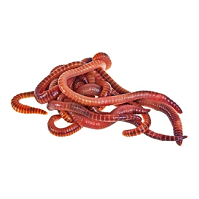Popular red worms: Tips for raising them
Popular red worms: Tips for raising them
Blog Article
Everything You Required to Find Out About Red Wigglers for Composting
Red wigglers, or Eisenia fetida, play an essential function in the realm of composting, changing natural waste into beneficial soil changes. The procedure of establishing up a worm container and maintaining it can pose challenges.
What Are Red Wigglers?

(buy red wiggler worms)
Belonging To The United States and copyright, red wigglers are surface-dwelling microorganisms that choose damp, cozy habitats rich in disintegrating raw material. Their diet is composed largely of rotting plant material, food scraps, and various other natural debris, which they consume and damage down efficiently. As they digest this material, they produce nutrient-rich spreadings that enhance soil fertility.
Red wigglers are hermaphroditic, having both male and women reproductive body organs, and can duplicate quickly under optimum conditions. This capability makes them an ideal choice for composting systems, as their populace can raise rapidly. Their strength and versatility to different settings better strengthen their value in sustainable waste management techniques. Generally, red wigglers are crucial contributors to the process of reusing natural waste into useful garden compost.
Advantages of Using Red Wigglers
Making use of red wigglers in composting systems offers various advantages that improve both the efficiency of waste monitoring and the high quality of the resulting compost. These worms, scientifically recognized as Eisenia fetida, are specifically efficient at breaking down raw material, transforming kitchen scraps and backyard waste right into nutrient-rich compost at a sped up rate.
Among the main benefits of making use of red wigglers is their ability to eat huge quantities of organic product, frequently refining their weight in food waste daily. This high usage rate results in faster decomposition and lowers the quantity of waste sent to land fills. In addition, the castings created by red wigglers are rich in vital nutrients, advantageous microbes, and enzymes, making them an excellent fertilizer for yards and plants.
Furthermore, red wigglers thrive in a range of atmospheres, making them adaptable for both indoor and exterior composting systems - red wigglers. Their presence in a compost container assists to aerate the material, avoiding smells and promoting a healthy composting process. Overall, using red wigglers not only adds to reliable waste management but additionally supports sustainable gardening methods with the production of high-grade garden compost
(Lake James Bait)
Establishing Your Worm Container
To effectively establish a worm bin, it is vital to pick an appropriate container that meets the demands of red wigglers while supplying a conducive setting for composting. An ideal bin can be made click now from plastic, wood, or metal, with a capacity of at least 1 square foot for each pound of worms.
Ensure the container has adequate water drainage holes to avoid excess moisture, as red wigglers grow in a wet, yet not water logged, setting. red wigglers. The container must also be ventilated to provide sufficient airflow, preventing anaerobic problems that can damage the worms
A perfect place for the worm bin is an awesome, dark area, devoid of straight sunlight and severe temperatures, as red wigglers choose a temperature level series of 55 to 77 levels Fahrenheit.
Prior to introducing the worms, prepare bed linen products such as shredded newspaper, cardboard, or coconut coir, which will certainly supply both environment and food. Moisten the bed linen gently to develop a welcoming environment for the worms. Lastly, take into consideration positioning a lid on the bin to keep humidity and decrease bugs, while guaranteeing it can be conveniently removed for maintenance.
Feeding and Treatment Guidelines
Feeding red wigglers is an important element of preserving a healthy and balanced composting system. These worms grow on a varied diet regimen, mostly composed of natural materials such as fruit and veggie scraps, coffee premises, and smashed eggshells. It is necessary to avoid feeding them meat, milk, and oily foods, as these can produce undesirable odors and bring in parasites.
When presenting food to your worm container, cut or shred products right into smaller sized items to facilitate quicker disintegration. Start with percentages to determine the worms' intake rate, progressively enhancing the amount as they adapt. It is recommended to alternate feeding locations within the bin to urge detailed blending and oygenation of the compost.

Troubleshooting Common Issues
Keeping a prospering worm composting system can occasionally offer obstacles that call for interest and troubleshooting. Common issues consist of an undesirable odor, which frequently indicates overfeeding or the visibility of anaerobic conditions. To treat this, reduce the amount of food added and guarantee correct oygenation by mixing the bedding material.
One more constant issue is the getaway of worms from the bin. This can occur due to too much dampness or inappropriate environmental conditions. On a regular basis inspect the moisture degrees, going for a wet however not soggy consistency, and preserve ideal temperatures in between 60-80 ° F(15-27 ° C )to produce a comfortable habitat for your red wigglers.
Bugs, such as fruit flies, can additionally attack worm bins. red wigglers. To battle this, cover food scraps with a layer of bed linen or shredded paper to hinder flies from laying eggs. Furthermore, ensure that any type of food included is fresh and totally free from mold and mildew, which can attract undesirable pests
Lastly, if your worms appear non-active, look for tension variables such as temperature fluctuations or insufficient moisture. Attending to these typical problems will certainly help preserve a healthy and balanced and efficient worm composting system.
Verdict
In summary, red wigglers, or Eisenia fetida, play a vital role in sustainable waste management through vermicomposting. Proper setup and maintenance of a worm bin, along with adherence to feeding guidelines, ensure a thriving ecosystem that decreases garbage dump payments.
Report this page